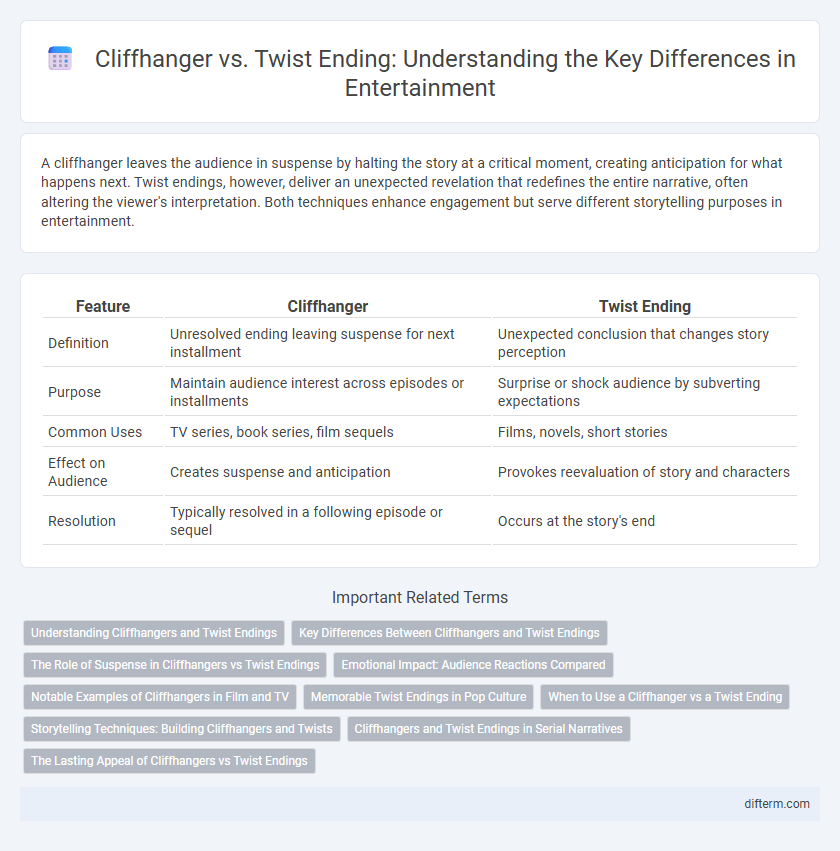A cliffhanger leaves the audience in suspense by halting the story at a critical moment, creating anticipation for what happens next. Twist endings, however, deliver an unexpected revelation that redefines the entire narrative, often altering the viewer's interpretation. Both techniques enhance engagement but serve different storytelling purposes in entertainment.
Table of Comparison
| Feature | Cliffhanger | Twist Ending |
|---|---|---|
| Definition | Unresolved ending leaving suspense for next installment | Unexpected conclusion that changes story perception |
| Purpose | Maintain audience interest across episodes or installments | Surprise or shock audience by subverting expectations |
| Common Uses | TV series, book series, film sequels | Films, novels, short stories |
| Effect on Audience | Creates suspense and anticipation | Provokes reevaluation of story and characters |
| Resolution | Typically resolved in a following episode or sequel | Occurs at the story's end |
Understanding Cliffhangers and Twist Endings
Cliffhangers create suspense by leaving key plot points unresolved, compelling audiences to anticipate the next installment, often used in television series and book chapters. Twist endings deliver unexpected conclusions that reframe the story, often altering the audience's perception of earlier events, common in films and novels. Both techniques enhance engagement by provoking emotional reactions and fostering deeper narrative investment.
Key Differences Between Cliffhangers and Twist Endings
Cliffhangers leave the audience in suspense by halting the narrative at a critical moment, creating anticipation for what happens next without revealing the outcome. Twist endings deliver a surprising revelation or change in the story's direction, often recontextualizing previous events and shocking the viewer or reader. Both devices heighten engagement, but cliffhangers extend tension beyond the story's end while twists provide a conclusive, unexpected resolution.
The Role of Suspense in Cliffhangers vs Twist Endings
Suspense in cliffhangers heightens audience anticipation by leaving key plot points unresolved at crucial moments, creating an urgent desire to know what happens next. In contrast, twist endings leverage suspense by subverting expectations in the final act, reshaping the narrative's meaning and compelling viewers to reevaluate earlier events. Both techniques rely on carefully managed tension, but cliffhangers extend suspense beyond the current episode or installment, while twist endings deliver a sudden, climactic release.
Emotional Impact: Audience Reactions Compared
Cliffhangers maximize emotional tension by leaving the audience in suspense, provoking anxiety and eagerness to discover what happens next. Twist endings generate shock and surprise, often recontextualizing the entire narrative and prompting viewers to reassess prior events. Both techniques evoke strong emotional responses, but cliffhangers sustain engagement over time while twists deliver immediate, intense impact.
Notable Examples of Cliffhangers in Film and TV
Iconic cliffhangers in film and TV include the explosive finale of "The Empire Strikes Back," where Darth Vader reveals his identity as Luke Skywalker's father, leaving audiences in suspense. The TV series "Lost" frequently employed cliffhangers, such as the shocking plane crash and mysterious island events that kept viewers eagerly anticipating the next episode. The series finale of "Breaking Bad" avoided a cliffhanger, instead opting for a conclusive ending, contrasting with shows like "The Sopranos," which famously ended on an ambiguous cut-to-black moment that sparked endless debate.
Memorable Twist Endings in Pop Culture
Memorable twist endings in pop culture often redefine the entire narrative, leaving audiences shocked and eager to revisit the story for hidden clues. Iconic examples like "The Sixth Sense," where the protagonist is revealed to be dead, or "Fight Club," with its dual-identity twist, showcase how unexpected conclusions can elevate a story's impact. These twist endings create lasting impressions, fostering fan theories and discussions that keep the entertainment experience alive beyond the screen.
When to Use a Cliffhanger vs a Twist Ending
A cliffhanger is best used at the end of an episode or chapter to maintain suspense and encourage audience anticipation for the next installment. A twist ending works well in self-contained stories or films where a surprising revelation redefines the narrative or character motivations. Choosing between a cliffhanger and a twist ending depends on whether the goal is to prolong engagement over time or deliver an immediate, impactful surprise.
Storytelling Techniques: Building Cliffhangers and Twists
Cliffhangers create suspense by leaving key plot points unresolved, compelling audiences to anticipate the next installment or revelation. Twist endings subvert expectations through unforeseen developments, enriching narrative depth and engagement. Effective storytelling balances cliffhangers and twists to maintain tension while delivering satisfying resolutions.
Cliffhangers and Twist Endings in Serial Narratives
Cliffhangers in serial narratives create suspense by leaving a critical plot point unresolved, compelling audiences to return for the next installment. Twist endings, on the other hand, deliver unexpected revelations that reframe the entire story, often concluding the narrative with shock or surprise. Both techniques enhance viewer engagement, but cliffhangers emphasize ongoing tension, while twists provide a definitive, often transformative, conclusion.
The Lasting Appeal of Cliffhangers vs Twist Endings
Cliffhangers create lasting suspense by leaving key plot points unresolved, compelling audiences to eagerly anticipate the next installment. Twist endings deliver a sudden, unexpected revelation that redefines the entire narrative, offering immediate shock and satisfaction. The enduring appeal of cliffhangers lies in their ability to sustain engagement over time, while twist endings capitalize on the power of surprise to leave a memorable impact.
cliffhanger vs twist ending Infographic

 difterm.com
difterm.com